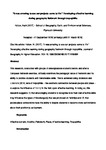“It was amazing to see our projects come to life!” Developing affective learning during geography fieldwork through tropophilia
| dc.contributor.author | Holton, M | |
| dc.date.accessioned | 2017-03-29T09:58:24Z | |
| dc.date.available | 2017-03-29T09:58:24Z | |
| dc.date.issued | 2017-02-08 | |
| dc.identifier.issn | 0309-8265 | |
| dc.identifier.issn | 1466-1845 | |
| dc.identifier.uri | http://hdl.handle.net/10026.1/8732 | |
| dc.description | peerreview_statement: The publishing and review policy for this title is described in its Aims & Scope. aims_and_scope_url: http://www.tandfonline.com/action/journalInformation?show=aimsScope&journalCode=cjgh20 | |
| dc.description.abstract |
This research, conducted with groups of undergraduate students before and after a European fieldwork exercise, critically examines the pedagogic value of fieldwork and its ability to provide students with transferable skills. This is achieved using Anderson and Erskine’s lens of tropophilia–the aesthetic connection between people and place–to explore the influence of “being” in the field upon affective learning. In doing so, this research suggests (1) that encouraging students to recognize how their own affective skills may influence the types of knowledge(s) that are produced on fieldtrips and (2) that people-place connections have the ability to inspire students to become more self-reflexive about their position(s) as learners. | |
| dc.format.extent | 1-15 | |
| dc.language | en | |
| dc.language.iso | en | |
| dc.publisher | Taylor & Francis (Routledge) | |
| dc.subject | Affective domain | |
| dc.subject | mobility | |
| dc.subject | fieldwork | |
| dc.subject | place | |
| dc.subject | affective learning | |
| dc.subject | tropophilia | |
| dc.title | “It was amazing to see our projects come to life!” Developing affective learning during geography fieldwork through tropophilia | |
| dc.type | journal-article | |
| dc.type | Article | |
| plymouth.author-url | https://www.webofscience.com/api/gateway?GWVersion=2&SrcApp=PARTNER_APP&SrcAuth=LinksAMR&KeyUT=WOS:000399322000004&DestLinkType=FullRecord&DestApp=ALL_WOS&UsrCustomerID=11bb513d99f797142bcfeffcc58ea008 | |
| plymouth.issue | 2 | |
| plymouth.volume | 41 | |
| plymouth.publication-status | Published | |
| plymouth.journal | Journal of Geography in Higher Education | |
| dc.identifier.doi | 10.1080/03098265.2017.1290592 | |
| plymouth.organisational-group | /Plymouth | |
| plymouth.organisational-group | /Plymouth/Faculty of Science and Engineering | |
| plymouth.organisational-group | /Plymouth/Faculty of Science and Engineering/School of Geography, Earth and Environmental Sciences | |
| plymouth.organisational-group | /Plymouth/REF 2021 Researchers by UoA | |
| plymouth.organisational-group | /Plymouth/REF 2021 Researchers by UoA/UoA14 Geography and Environmental Studies | |
| plymouth.organisational-group | /Plymouth/Research Groups | |
| plymouth.organisational-group | /Plymouth/Research Groups/Centre for Research in Environment and Society (CeRES) | |
| plymouth.organisational-group | /Plymouth/Research Groups/Centre for Research in Environment and Society (CeRES)/CeRES (Reporting) | |
| plymouth.organisational-group | /Plymouth/Users by role | |
| plymouth.organisational-group | /Plymouth/Users by role/Academics | |
| dcterms.dateAccepted | 2016-09-22 | |
| dc.rights.embargodate | 2018-2-8 | |
| dc.identifier.eissn | 1466-1845 | |
| dc.rights.embargoperiod | 18 months | |
| rioxxterms.versionofrecord | 10.1080/03098265.2017.1290592 | |
| rioxxterms.licenseref.uri | http://www.rioxx.net/licenses/under-embargo-all-rights-reserved | |
| rioxxterms.licenseref.startdate | 2017-02-08 | |
| rioxxterms.type | Journal Article/Review |


